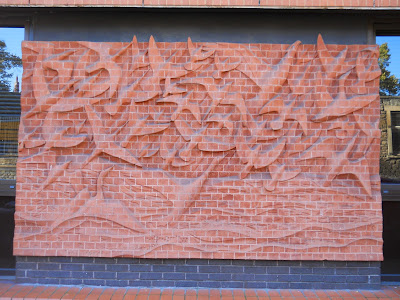I've been very busy for the last month or two working on a big new bench that will go onto the Downs. Very few large pieces of sculpture are allowed to be permanently placed there, so it's a really exciting project.
The bench is made from oak that grew nearby and it was milled near Chelvey, just down the road. The work on making the bench has been done at my studio at Bower Ashton, so it really is a local bench for Bristol. I'm carving one of the two backrests in the photo above. Each is about 2.5 metres (about 8 feet) long and 7.5cm (3") thick. Pretty sturdy!
The bench is scheduled to be finished by December and then installed in the children's playground next to the Observatory and the Suspension Bridge in March 2015.
It will be a cross between an information board and a bench, so people can read about wildlife and people associated with the area while having a comfy place to sit. There will also be a 'treasure trail' of carved little spiders for visitors to find; some easy to spot, some not so easy!
Here's a preview of a few of the other carvings for you to see:
The purseweb spider, a tiny relative of tarantulas that lives in the Avon Gorge.
The 'Bristol Dinosaur', Thecodontosaurus
Carving one of the bearers that will hold the bench up. It shows a brachiopod, a shellfish that is found fossilised in the Carboniferous limestone under the Downs. Much larger than life-sized though!
This bearer shows the coral Lithostrotion, also found in the Carboniferous limestone.
Chalkhill Blue butterflies live in the Gorge. They are nationally uncommon, living in very specific areas in the south of England.
This is Libby Houston, who is a poet, botanist and rope access expert. She has had several books of poetry published, and gave permission for me to carve two lines from her poem 'The Trees Dance' onto the bench. They read:
'Forest-father, mighty Oak,
on my back the lightning-stroke'
Libby spends much of her time abseiling into the Avon Gorge and mapping the rare plants that live there. For her work, she was awarded the prestigious H.H. Bloomer award by the Linnean society. Amongst other achievements, she has discovered some of the very rare hybrids of Whitebeam trees that grow in the hard-to-reach parts of the Gorge and nowhere else, one is even named after her: Sorbus x houstoniae. There is only one specimen of this tree known to exist and Libby kindly gave me some examples of its leaves to copy.
I researched most of the information for the bench myself, but could not have done it without the help and advice of a few people, who I'd like to thank here;
Francis Greenacre has been a great help, providing feedback, liaising with the members of the Clifton and Hotwells Improvement Society (who commissioned the bench) and also supplying very useful images and ideas, particularly about Brunel's designs for the Suspension Bridge. Thanks also to RoseMary and Linda of CHIS, for meeting and chatting about ideas.
Ray Barnett, Mark Pajak and Isla Gladstone at Bristol Museum and Art Gallery all gave their time to meet and discuss ideas and images for wildlife and fossil subjects to use. Mark and Isla also supplied very helpful images to use.
Dr Clive Lovatt, Richard Bland and Linda Edwards helped in researching the poetry featured on the bench, as well as supplying information about local poet Peter Gabbitass who is one of the subjects.
Libby Houston very kindly gave permission to use her poetry and supplied leaves to copy, as well as explaining her work and checking the facts were correct! It was great to meet her.
Thanks also to Joe Cooper of Touchwood Enterprises, Andy O'Neill and Sam Mond, without whom I might not have had any local timber to carve into in the first place.
























































